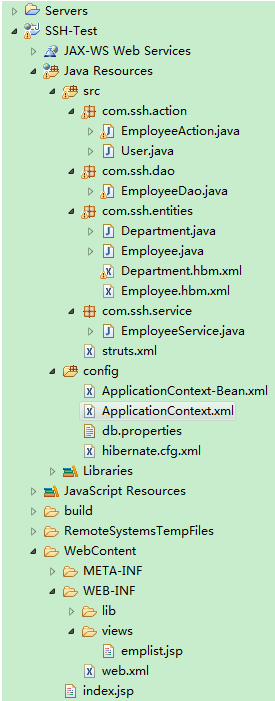一、目录结构:
二、环境搭配
1. 导入jar包
2. 配置web.xml(直接复制即可)
<?xml version="1.0" encoding="UTF-8"?>
<web-app xmlns:xsi="http://www.w3.org/2001/XMLSchema-instance" xmlns="http://xmlns.jcp.org/xml/ns/javaee" xsi:schemaLocation="http://xmlns.jcp.org/xml/ns/javaee http://xmlns.jcp.org/xml/ns/javaee/web-app_3_1.xsd" id="WebApp_ID" version="3.1">
<display-name>SSH-Test</display-name>
<welcome-file-list>
<welcome-file>index.jsp</welcome-file>
</welcome-file-list>
<!-- 配置 Spring 配置文件的名称和位置 -->
<context-param>
<param-name>contextConfigLocation</param-name>
<param-value>classpath:ApplicationContext*.xml</param-value>
</context-param>
<!-- 启动 IOC 容器的 ServletContextListener -->
<listener>
<listener-class>org.springframework.web.context.ContextLoaderListener</listener-class>
</listener>
<!-- 配置 Struts2 的 Filter -->
<filter>
<filter-name>struts2</filter-name>
<filter-class>org.apache.struts2.dispatcher.ng.filter.StrutsPrepareAndExecuteFilter</filter-class>
</filter>
<filter-mapping>
<filter-name>struts2</filter-name>
<url-pattern>/*</url-pattern>
</filter-mapping>
</web-app>3. 配置struts.xml,初始结构
<?xml version="1.0" encoding="UTF-8" ?>
<!DOCTYPE struts PUBLIC
"-//Apache Software Foundation//DTD Struts Configuration 2.3//EN"
"http://struts.apache.org/dtds/struts-2.3.dtd">
<struts>
<constant name="struts.enable.DynamicMethodInvocation" value="false" />
<constant name="struts.devMode" value="false" />
<package name="default" namespace="/" extends="struts-default">
<action name="emp-*" class="employeeAction" method="{1}">
<result name="list">/WEB-INF/views/emplist.jsp</result>
<result name="delete" type="redirect">/emp-list</result>
</action>
</package>
</struts>
4. 在config文件夹中设置db.properties
jdbc.user=root
jdbc.password=root
jdbc.driverClass=com.mysql.jdbc.Driver
jdbc.jdbcUrl=jdbc:mysql://127.0.0.1:3306/ssh
jdbc.initialPoolSize=5
jdbc.maxPoolSize=10
5.在config文件夹中配置ApplicationContext.xml
负责和数据库的一些连接配置,与上步db.properties关联。一般直接复制即可
<?xml version="1.0" encoding="UTF-8"?>
<beans xmlns="http://www.springframework.org/schema/beans"
xmlns:xsi="http://www.w3.org/2001/XMLSchema-instance"
xmlns:aop="http://www.springframework.org/schema/aop"
xmlns:context="http://www.springframework.org/schema/context"
xmlns:mvc="http://www.springframework.org/schema/mvc"
xmlns:p="http://www.springframework.org/schema/p"
xmlns:tx="http://www.springframework.org/schema/tx"
xsi:schemaLocation="http://www.springframework.org/schema/beans http://www.springframework.org/schema/beans/spring-beans.xsd
http://www.springframework.org/schema/aop http://www.springframework.org/schema/aop/spring-aop-4.0.xsd
http://www.springframework.org/schema/context http://www.springframework.org/schema/context/spring-context-4.0.xsd
http://www.springframework.org/schema/mvc http://www.springframework.org/schema/mvc/spring-mvc-4.0.xsd
http://www.springframework.org/schema/tx http://www.springframework.org/schema/tx/spring-tx-4.0.xsd">
<context:property-placeholder location="classpath:db.properties"/>
<bean id="dataSource" class="com.mchange.v2.c3p0.ComboPooledDataSource">
<property name="user" value="${jdbc.user}"></property>
<property name ="password" value="${jdbc.password}"></property>
<property name="driverClass" value="${jdbc.driverClass}"></property>
<property name="jdbcUrl" value="${jdbc.jdbcUrl}"></property>
<property name="initialPoolSize" value="${jdbc.initialPoolSize}"></property>
<property name="maxPoolSize" value="${jdbc.maxPoolSize}"></property>
</bean>
<bean id="sessionFactory" class="org.springframework.orm.hibernate4.LocalSessionFactoryBean" >
<property name="dataSource" ref="dataSource"></property>
<property name="configLocation" value="classpath:hibernate.cfg.xml"></property>
<property name="mappingLocations" value="classpath:com/ssh/entities/*.hbm.xml"></property>
</bean>
</beans>
6. 在src中建立包,例com.ssh.entities,com.ssh.action,com.ssh.service,com.ssh.dao
entities负责实体,一般和数据库相匹配,建立好.java类后,还要建立一个 heiberate数据库关联文件.hbm.xml。
例:Department.java:
package com.ssh.entities;
public class Department {
private Integer deptId;
private String deptName;
public Integer getDeptId() {
return deptId;
}
public void setDeptId(Integer deptId) {
this.deptId = deptId;
}
public String getDeptName() {
return deptName;
}
public void setDeptName(String deptName) {
this.deptName = deptName;
}
}例:Department.hbm.xml:
<?xml version="1.0"?>
<!DOCTYPE hibernate-mapping PUBLIC "-//Hibernate/Hibernate Mapping DTD 3.0//EN"
"http://hibernate.sourceforge.net/hibernate-mapping-3.0.dtd">
<!-- Generated 2016-6-10 21:13:26 by Hibernate Tools 3.4.0.CR1 -->
<hibernate-mapping>
<class name="com.ssh.entities.Department" table="SSH_DEPARTMENT">
<id name="deptId" type="java.lang.Integer">
<column name="DEPT_ID" />
<generator class="native" />
</id>
<property name="deptName" type="java.lang.String">
<column name="DEPT_NAME" />
</property>
</class>
</hibernate-mapping>
action负责响应行为。
package com.ssh.action;
import java.util.Map;
import org.apache.struts2.interceptor.RequestAware;
import org.springframework.web.context.request.RequestAttributes;
import com.ssh.service.EmployeeService;
import com.opensymphony.xwork2.ActionSupport;
public class EmployeeAction extends ActionSupport implements RequestAware{
private static final long serialVersionUID = 1L;
private EmployeeService employeeService;
private Integer id;
public void setId(Integer id) {
this.id = id;
}
public void setEmployeeService(EmployeeService employeeService) {
this.employeeService = employeeService;
}
public String list()
{
request.put("employees", employeeService.getAll());
request.put("111", employeeService.getAll());
return "list";
}
public String delete()
{
employeeService.deleteEmployee(id);
return "delete";
}
private Map<String,Object> request;
@Override
public void setRequest(Map<String, Object> arg0) {
// TODO Auto-generated method stub
this.request=arg0;
}
}
service调用dao的方法。
package com.ssh.service;
import java.util.List;
import com.ssh.dao.EmployeeDao;
import com.ssh.entities.Employee;
public class EmployeeService {
private EmployeeDao employeeDao;
public void setEmployeeDao(EmployeeDao employeeDao) {
this.employeeDao = employeeDao;
}
public List<Employee> getAll()
{
return employeeDao.getAll();
}
public void deleteEmployee(Integer id)
{
employeeDao.deleteEmployee(id);
}
}
dao负责数据库的一些操作方法。
package com.ssh.dao;
import java.util.List;
import org.hibernate.Query;
import org.hibernate.Session;
import org.hibernate.SessionFactory;
import com.ssh.entities.Employee;
public class EmployeeDao {
private SessionFactory sessionFactory;
public void setSessionFactory(SessionFactory sessionFactory) {
this.sessionFactory = sessionFactory;
}
private Session getSession()
{
//return sessionFactory.getCurrentSession();
return sessionFactory.openSession();
}
public List<Employee> getAll()
{
String sql="FROM Employee e LEFT OUTER JOIN FETCH e.dept";
return getSession().createQuery(sql).list();
}
public void deleteEmployee(Integer id)
{
String sql="delete from Employee e where e.id = ?";
Query query=getSession().createQuery(sql).setInteger(0, id);
query.executeUpdate();
}
}
7.建立好src框架后,在config文件夹中配置ApplicationContext-Bean.xml
ApplicationContext-Bean.xml 负责将action,service,dao联系起来。
<?xml version="1.0" encoding="UTF-8"?>
<beans xmlns="http://www.springframework.org/schema/beans"
xmlns:xsi="http://www.w3.org/2001/XMLSchema-instance"
xmlns:aop="http://www.springframework.org/schema/aop"
xmlns:context="http://www.springframework.org/schema/context"
xmlns:mvc="http://www.springframework.org/schema/mvc"
xmlns:p="http://www.springframework.org/schema/p"
xmlns:tx="http://www.springframework.org/schema/tx"
xsi:schemaLocation="http://www.springframework.org/schema/beans http://www.springframework.org/schema/beans/spring-beans.xsd
http://www.springframework.org/schema/aop http://www.springframework.org/schema/aop/spring-aop-4.0.xsd
http://www.springframework.org/schema/context http://www.springframework.org/schema/context/spring-context-4.0.xsd
http://www.springframework.org/schema/mvc http://www.springframework.org/schema/mvc/spring-mvc-4.0.xsd
http://www.springframework.org/schema/tx http://www.springframework.org/schema/tx/spring-tx-4.0.xsd">
<bean id="employeeDao" class="com.ssh.dao.EmployeeDao">
<property name="sessionFactory" ref="sessionFactory"></property>
</bean>
<bean id="deptDao" class="com.ssh.dao.deptDao">
<property name="sessionFactory" ref="sessionFactory"></property>
</bean>
<bean id="employeeService" class="com.ssh.service.EmployeeService">
<property name="employeeDao" ref="employeeDao"></property>
<property name="deptDao" ref="deptDao"></property>
</bean>
<bean id="employeeAction" class="com.ssh.action.EmployeeAction" scope="prototype">
<property name="employeeService" ref="employeeService"></property>
</bean>
</beans>
到此,整个框架就搭起来了。
现在可以写你的页面了。
emplist.jsp
<%@ page language="java" contentType="text/html; charset=UTF-8"
pageEncoding="UTF-8"%>
<%@taglib prefix="s" uri="/struts-tags" %>
<!DOCTYPE html PUBLIC "-//W3C//DTD HTML 4.01 Transitional//EN" "http://www.w3.org/TR/html4/loose.dtd">
<html>
<head>
<meta http-equiv="Content-Type" content="text/html; charset=UTF-8">
<title>Insert title here</title>
</head>
<body >
<h3 align="center">Employee list page</h3>
<s:if test="#request.employees==null || #request.employees.size()==0">
没有任何员工信息
</s:if>
<s:else>
<table border="1" cellpadding="10" cellspacing="0" align="center">
<tr>
<td>ID</td>
<td>NAME</td>
<td>EMAIL</td>
<td>BIRTH</td>
<td>dept</td>
<td>DELETE</td>
<td>UPDATE</td>
</tr>
<s:iterator value="#request.employees">
<tr>
<td>${id}</td>
<td>${name}</td>
<td>${email}</td>
<td>${birth}</td>
<td>${dept.deptName}</td>
<td><a href="emp-delete?id=${id}">delete</a></td>
<td><a href="emp-update?id=${id}">update</a></td>
</tr>
</s:iterator>
</table>
</s:else>
</body>
</html>在index.jsp中调用action方法,从而显示emplist.jsp页面
<%@ page language="java" contentType="text/html; charset=UTF-8"
pageEncoding="UTF-8"%>
<!DOCTYPE html PUBLIC "-//W3C//DTD HTML 4.01 Transitional//EN" "http://www.w3.org/TR/html4/loose.dtd">
<html>
<head>
<meta http-equiv="Content-Type" content="text/html; charset=UTF-8">
<title>Insert title here</title>
</head>
<body>
<a href="emp-list"> list all employee</a>
</body>
</html> 





















 3199
3199











 被折叠的 条评论
为什么被折叠?
被折叠的 条评论
为什么被折叠?








